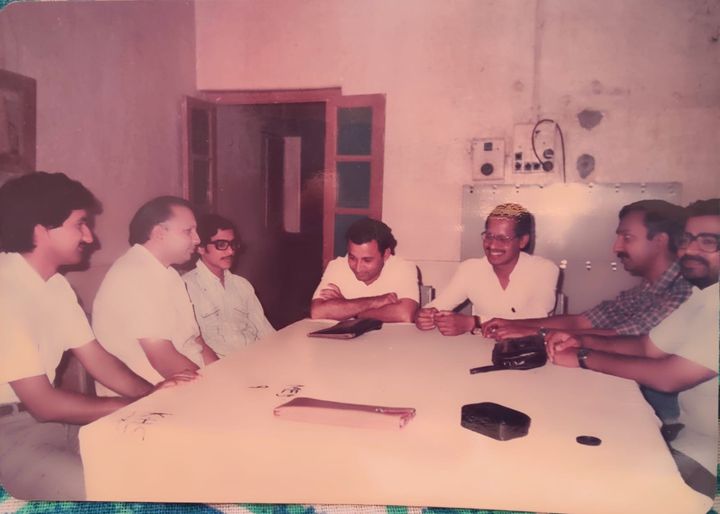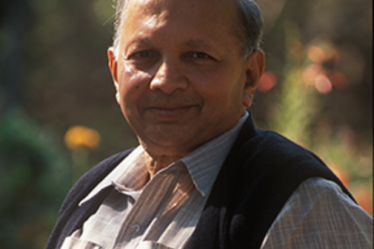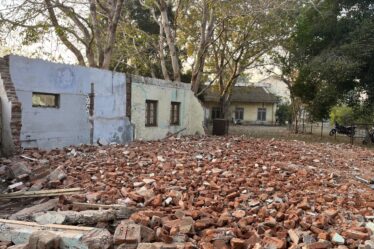
In November 1981, I earned my MD in Medicine from the Government Medical College, Nagpur. Guided by Dr. BS Chaubey, known for his razor-sharp mind, clinical acumen, and rapid-fire diagnoses, I underwent rigorous training. His witty and incisive remarks during ward rounds were a hallmark of his teaching style.
Spending two-and-half years in Ward 23 of the GMC hospital, I faced the challenges of residency head-on. Dr. Chaubey’s uncompromising standards allowed no margin for error; he seldom suffered fools gladly and didn’t hesitate to send erring residents packing with sharp remarks.
He left a lasting impression on all who trained under him.
____________________________________
A month after earning my MD and feeling uncertain about my next steps, I met Dr. Ulhas Jajoo, a close acquaintance from childhood. His younger brother, Suhas, and I had studied together from school through MBBS and postgraduation. Both Ulhas and I were mentored by Dr. BS Chaubey at GMC Nagpur for our medical education, and our families had been closely connected in Wardha for five decades.
Ulhas was then a lecturer in Medicine.
“What are your plans?” he asked. “I’m not sure. My father wants me to start a practice in Wardha, but I’m not keen.”
“Why not join the Department of Medicine at MGIMS? Sevagram has an opening for a senior registrar and can accommodate you,” Ulhas suggested.
____________________________________
I nodded and the next day rode my Vespa to Kasturba Hospital. There, I met Dr. KK Trivedi, the surgical professor and hospital superintendent.He wore a pristine white Khadi shirt and trousers. His large, stoic frame and spectacles framed a face radiating intelligence and dedication. Despite his mild and courteous demeanor, he evoked awe.
After a brief exchange of questions, he welcomed me to join the department.
On May 5, 1982, a hot afternoon, I entered the medicine ward of MGIMS Sevagram hospital. Unlike the bustling corridors of Government Medical College, Nagpur, where I trained, this hospital exuded calmness. There, I encountered an unkempt resident performing a procedure at a patient’s bedside, stethoscope always around his neck—a constant companion.
He looked at me with a puzzled expression and asked who I was and why I was there. Feeling self-conscious under his gaze, I explained that I was the new senior resident in the medicine department, hoping to meet Dr. OP Gupta, the department head. A sweet smile lit up his face as he took off his glove, shook my hand, and introduced himself as Krishan, adding, “You can call me Kissu,” his face beaming with sheepish grin and childlike innocence.
This was KK Aggerwal.
A week later, I understood why his reputation as an enfant terrible and prodigy was well deserved. His residency was a flurry of action: by 7:30 am, he had already finished rounds, ordered tests, and written discharge summaries. By 8:00 am, he was ready for case presentations and journal clubs. His energy and efficiency were remarkable.
During his days as a medical student at MGIMS in the early 1980s, he consistently made accurate diagnoses, relying solely on clinical acumen without the aid of modern imaging or advanced biochemistry. His diagnostic prowess was truly exceptional.
____________________________________
The Medicine wards were situated in the old hospital building, now occupied by the Community Medicine department. The makeshift ICU lacked essential equipment like ventilators, multipara monitors, and infusion pumps. There were no echo or ultrasound machines, nor a computerized hospital information system. The wards had towering Kavelu roofs, stone tiles, and walls whitewashed over the years, with aging wooden doors and leaking taps.
Our PG activity room, possibly a converted former operating theatre with simple white porcelain tiles, served as our cerebral center. Here, we discussed clinical cases, made ECG diagnoses, and reviewed chest X-rays. For outpatient consultations, Dr. AP Jain and I would climb the hill to the newly constructed building on Tuesdays and Fridays. In those three-hour clinics, we typically saw only 40-50 patients. With plenty of time to pass, we discussed everything under the sun, including the sun.
When I joined Dr. AP Jain’s unit as a senior registrar, the department was led by three unit heads: Dr. OP Gupta, Dr. AP Jain, and Dr. Ulhas Jajoo. My co-registrars were Kamal Pervez and JP Sharma, the latter from the MGIMS 1972 batch. As for residents, there were just two: Ashok Birbal, who didn’t use the suffix Jain at that time, and Hari Om, who had dropped Arora as his last name.
___________________________________
The department’s roster featured a series of P-named physicians: OP, AP, KP, JP, and myself, SP. VP (Vivek Poflee) was set to join soon.
The early 80s heralded a golden era for the Medicine department at MGIMS, driven by the “P’s” – KP, JP, SP, OP, and AP. Dynamic young lecturers like Dr. Kamal Pervez and Dr. JP Sharma were deeply attuned to patient care. I, SP Kalantri, joined as a senior registrar during this time.
Like the “P” waves in the ECG, the “P” professors—Dr. SP Nigam, Dr. OP Gupta, and Dr. AP Jain—were revered figures whose influence resonated throughout the institute. They took the department to new heights.
Dr. Pervez was elegant and sophisticated, with a charm that captivated everyone. Dr. JP Sharma, known for his practical approach and use of UP-Hindi, was loved for his simple lifestyle.
Despite having limited resources—each unit had only one consultant, one lecturer, and one house officer—the department operated efficiently. We handled OPDs, ward admissions, consultations, PG activities, and even mortality meetings without any issues.
As one of the “P’s,” I (SP) feel proud and honored to have been part of such a talented and dedicated team. The legacy of the “P’s” lives on, continuing to profoundly impact the department.
_____________________________________
The first MD exam in our department just finished, but the lone candidate didn’t meet the teacher’s expectations. Drs. Gupta and Jain, who had mentored her closely, felt let down. Despite doing well in her long and short cases, she became tongue-tied in the viva voce. Nervousness got the better of her.. However, she managed to impress the examiners in the end.
_____________________________________
“This year’s PG didn’t perform well at the bedside,” Dr. Gupta lamented.
“Indeed,” Dr. Jain agreed, shaking his head. “I don’t know what happened with this batch. We teach them thoroughly, train them for the exams, give them ample practice, and conduct PG activities regularly. Yet, when it matters, they just don’t deliver.”
And so the story went, year after year, for four decades. Every batch seemed to fall short of the previous ones, in the eyes of the venerable professors.
I couldn’t help but be amused to hear the same lament year after year. When I eventually became an examiner, I found myself joining in the chorus, telling the same story about how the previous batches were always better than the current ones.
______________________________________
Disappointed by their MD student’s performance, Dr. Gupta, who was leading the department at the time, mandated twice-daily PG activities. It didn’t matter that it was a vacation month for the faculty, or that it was sweltering May with only a ceiling fan in the PG room and no cooler or air conditioner.
Only four days into my new role, I found myself leading a journal club. Caught off guard, I hastily prepared my presentation using handwritten notes in blue, black, and red ink—there were no computers or PowerPoint slides to rely on. Despite the makeshift setup, I discussed research papers from the BMJ and the Lancet, and managed to handle probing questions from three different professors, each with a unique style.
Coming from GMC Nagpur with Dr. BS Chaubey as my mentor, I was keenly aware of the high expectations placed on me. It was a sweltering May afternoon, around 2 pm, and the tension and heat had parched my tongue, quickened my heartbeat, and added a slight tremor to my voice.
I breathed a sigh of relief as the journal club concluded and quickly sought out a glass of not-so-cool water.
For the next forty years, I continued to work with Drs Gupta, Jain and Jajoo.
As for these teachers and their unique teaching styles, that’s a story for another time.


Wonderful writeup Sir 🙏 Nostalgic. Please continue with this series of medicine department !
Respected sir you are great teacher and doctor.
Too bad our paths didn’t cross, I get this uncanny feeling that I know you well from all your writings. Pray someday our paths converge.
Great teachers like Dr OP Gupta Sir Dr Jain Sir Dr Ulhas Jajoo Sir Namaskar to All In few weeks of work they must have recognised the talent and hard work of Dr S P SP Kalantri Sir Vidwan Sarvatra Pujhate
A great write up. Thank you. You have all gone on to inspire so many trainees 🙏
Thanks for the captivating write-up Sir. I smiled through it imagining our revered teachers including you Sir in the earlier years. 🙏🏻
Thank you Sir, your write ups take us back to the corridors of Medicine department and all the memories attached .
The PG meet room and the long cases memories came flooding in . 😨😰
We were lucky to have the great” P”stalwarths mentor us. I still remember my first bedside clinic with Kalantri sir. He took a torch and illuminated the waves of the jugular vein of a patient across the wall. And introduced us,awestruck newcomers to A C E Waves. I don’t think any other teacher could have done this miracle.
I was a fan of the elegance , the clarity of concepts and vocabulary Kalantri Sir carreief. Never missed a single class or clinic.
When you go out of Sevagram..you get to know what MGIMS has given you;What khadi symbolizes and no fabric can match its class;Why a clinician’s touch is regarded more important than the highest generation of the antibiotics and how to restrict yourself,the most difficult part in some situations during the management of certain diseases that is ‘knowing where NOT to treat.’
Those who are trained under the stalwarts of medicine at MGIMS,should consider themselves utmost fortunate!!
Real and true writing on to medicine department.. Left Sevagram to IGMC .month before you joined . Hope to see you next year on our Golden Jubilee.
Wonderful writing as usual Sir, a revelation though that you were from Wardha too. I could relate to many things as we shifted from Pulgaon to Sevagram in 1978 as my father Late Col. Mulay retired from active duty as Comdt CAD, Pulgaon. One fine day as my father visited and met Badi Behenji who asked him Col sahab retirement ke baad kya and he said kuch socha nahi and Behenji asked him to join KHS😊
Memorable journey sir. Still lot to learn from you and your teachings. And the way you shaped your dept and the institute.
All legends in one frame! It is a great honor for me to read about the MGIMS and Medicine Department registrar journey of my mentor, Dr. SP Kalantri. 🙏
PowerPoint presentations they are called, but your unique style of writing and designing those slides gives them the additional power to express what you really want to explain in the easiest way! I have presented many presentations that you helped prepare and design, and I won many prizes during my residency.
Wonderful write up and reminisces Sir. Medicine department was remarkable.
Lovely write up . Our teachers in Sevagram were so dedicated and meticulous about their responsibilities ! When I completed my education in Sevagram and applied for Senior Residency in Lady Hardinge Medical College, i was selected for the position without even a formal interview , only on the reputation of my Alma Mater….such was the reputation of our Medical school .
Dear SP,
Your unique style of writing makes all your posts a pleasant reading. It’s great you have still preserved old photos & related memoirs. It’s always a pleasant journey down the memory lane.
Vivek
Yet another beautiful write-up, Sir. I was fortunate to be a part of the Department of Medicine as a postgraduate student and later as a faculty member. I have been privileged to be mentored by the four pillars of our department: Om Prakash Gupta Sir, A.P. Jain Sir, Jajoo Sir, and you.
Memories came flooding back after reading your message. I fondly remember your yellow Vespa, the lunches we shared, and the times we spent sitting on that Vespa. Your beautiful handwriting and excellent style of delivery left an indelible impression on me. Failing my MD exam was painful, but your company was a great stress buster during that challenging time. I also recall you wanted to start painting, though I believe you have not yet begun.
I got very nostalgic. Back in 1985, it was incredibly challenging for me to choose between medicine and pediatrics. I almost opted for medicine, particularly because of the brilliant teaching from you, OPG, APJ, and Ulhas sir.
Beautiful write up as always.. The ‘P’s along with non ‘P’s worked hard to set a very high bench mark of teaching which still resonates in mind..
What a perfect depiction of Dr Karunakar Trivedi and Dr KK Aggrawal..
Looking forward to further write ups on teachers and their teaching style..
A great write up as always meandering us through the memory lanes as if we were still there It was always satisfying to be mentored by giants of medicine with their clinical nuggets and secret one liners which were always interesting and still help us thanks
It’s always a pleasure to read your write ups and reminisce about those days having grown up in Sevagram. There was another ‘P’, Dr Poflee who used to teach our batch. Don’t remember where he went after he left Sevagram. Isn’t he the one sitting in the picture between Dr Jain and Dr Jajoo?
Dr Poflee taught me too ,very humble ,knowledgeable and simple person suited the most to our MGIMS environment I would say ..Good teacher indeed.